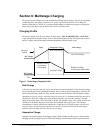
Prosine 2.5/3.0 Installation & Operation Guide 67
Section 7: Batteries
This section of the manual is included to help you better understand the factors involved with battery
charging, care, and maintenance, by discussing the physical make-up and characteristics of chemical
storage batteries. This is not intended to be an exhaustive discussion of battery types, but simply a
guideline. The manufacturer of each specific battery is the best authority as to its use and care.
Batteries come in different sizes, types, amp-hours, voltages and chemistries. It is not possible here to
discuss all aspects in detail. However, there are basic guidelines you can follow that will help in
battery selection and ensure that your batteries are better maintained than the majority.
Terminology
A description of battery charger operation requires the use of terms with which you may not be
familiar. The following terms appear in the description of batteries and battery charger operation.
Electrolyte Typically a mixture of water and sulfuric acid, it is commonly referred to as battery acid.
Plates Originally made of lead, now fabricated from lead oxide. Plates connect to the battery
terminals and provide a structure for the chemicals that create current. There are several plates in each
cell, each insulated from the other by separators.
Sulfating As a battery discharges, its plates become covered with lead sulfate. During recharging,
the lead sulfate leaves the plates and recombines with the electrolyte. If the lead sulfate remains on
the plates for an extended period of time (over two months), it hardens, and recharging will not
remove it. This reduces the effective plate area and the battery’s capacity. Equalization helps reduce
sulfation on flooded batteries.
Stratification Over time, a battery’s electrolyte (liquid) tends to separate. The electrolyte at the top
of the battery becomes watery while at the bottom it becomes more acidic. This effect is corrosive to
the plates. Equalization helps reduce stratification.
Deep Cycle A deep cycle occurs when a battery is discharged to less than 50% of its capacity (50%
depth-of-discharge). A deep cycle battery is one that is intended to be repeatedly, deeply discharged
and charged.
Temperature Compensation Optimal battery charging voltage is temperature dependent. As
ambient temperatures fall, the proper voltage for each charge stage needs to be increased. A battery
temperature sensor automatically re-scales charge-voltage settings to compensate for ambient
temperatures. The compensation slope based on cell voltage is -2.17mv per degree Fahrenheit per cell
(30mv per degree Celsius) for lead-acid batteries.
Types
There are two principal types of batteries: starting and deep-cycle. There are several different types of
battery chemistries including flooded lead-acid, nickel-iron (NiFe), nickel-cadmium (NiCad),
alkaline, and gel-cell just to name a few. Batteries are either sealed or vented. However, there are even
different kinds of these batteries. This section explains some of the differences between the different
lead acid batteries to help you choose a battery which best suits your needs.


















